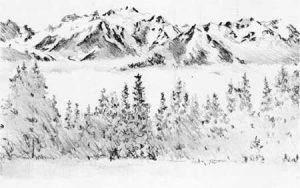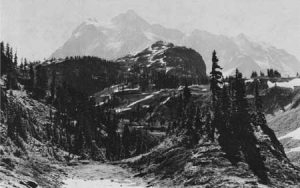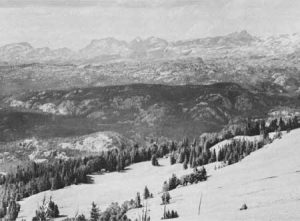INTRODUCTION

Forestry in the United States was still in a "mistydawn" at the beginning of the current century. However, it was inevitable from the beginning that forest conservation should play a major role in the development of this country. Here was a land singularly rich in natural resources, of which our forests were dominant. Trees grew in all parts of this land except in grasslands, the desert regions of the Great Plains, and the arid basins of the West. The original timber land was estimated at 950 million acres. Forests extended almost unbroken from the Atlantic Coast to the Great Plains,and began again to the west where they ranged in increasing numbers to climax in the giants of the Pacific Coast.
It is generally accepted today that there stillremains about two-thirds of the original forest lands. This, despite thefact that as early as 1865 a timber famine was predicted within 30years. Differences of opinion and conflict have marked the course ofconservation throughout our Nation's history.
The majority of the people, particularly during thecountry's formative years, regarded the forests as an inexhaustibleresource. Land had to be cleared of trees to make it suitable for (1)agricultural purposes, (2) roads, and (3) settlements. To pioneers theforest seemed an obstacle to progress and safety. Wood was an essentialingredient to pioneer livelihood, but it was overabundant and free forthe taking. Also, the forests added to the dangers, for they harboredIndians and wild animals.
Still, there were those settlers in America who,coming from lands where forests had been depleted, brought with them theconviction that the forest was a valuable resource and should not bewasted. Restrictions on cutting and burning forest land appeared earlyin the Colonies. These laws were aimed mostly at protecting the propertyof others and reserving large white pines as masts for the British RoyalNavy. Soon after the Colonies gained their independence, specialreserves of live oak trees were set aside along the southern coasts toprovide timbers for naval vessels.
So, there appeared two sides to the conservation coin early in our history. These will appear and reappear as we focus on the several distinct periods of development of forest conservation in America. Sometimes these will appear as merely differences of opinion,while at other times they present themselves as confrontations and even conflict.

Figure 1.—Mt. Shuksan, Wash. F—355266
In colonial days, naturally being highlighted first in our chronology, two important facts stand out: the settlers were energetic, intelligent, independent, and ambitious people and gradually came to need the help of the mother country less and less; and, to the west was a great land with very few inhabitants. America was largely a wilderness, with an abundance of fertile soil, most of the minerals required by modern industry, vast forests, and water for crops, power,and other uses. These resources greatly influenced the development of the country and the lives of its people, and helped make the country rich. Sheer abundance, however, often led early Americans into wasteful habits, such as farming fields continuously until the land began to wear out, needlessly destroying wide forest areas by poor logging methods,and recklessly slaughtering wildlife, such as the buffalo. A few farsighted and public-spirited people tried from time to time to arouse realization of the dangers that lay ahead if wasteful destruction offorests were not checked, but they were as voices crying in the wilderness. To most people it seemed the forests would last forever.
The next highlight covers a period to be characterized by one word—exploitation. The restrictions imposed by a foreign sovereignty were thrown off. Although the British trade restrictions had been much lighter than those imposed by other countries on their colonies, the Americans had become such strong individualistst hat they resented any controls. Now the pendulum swung the other way—expansion which knew no bounds was the order of the day.
A census of 1790 showed that about 4 million personslived in the United States. Most of them lived along the Atlanticseacoast, either in villages or on farms. Only about 100,000 hardysettlers had ventured west of the Allegheny Mountains. But the countrygrew rapidly. People thought little of hardships so long as they couldget ahead in the world. Prosperity grew mainly because land cost solittle, and the forests seemed to be everywhere. This resulted in asmany trees being burned to clear the land as were used for building,furniture, utensils, tools, railroad ties, or firewood. The 19th centurysaw lumbering develop and spread on a colossal scale until nearly allthe original forests were cut over, from the Atlantic Ocean to the GreatPlains. This cutting was often followed by severe fires, whichfrequently prevented the forests from renewing themselves.
Jefferson's promotion of agriculture and theLouisiana Purchase were most important in this period of nationalgrowth. The United States had grown amazingly in the years afterJefferson took office. Settlement had reached as far west as theMissouri River, and the population had passed 17 million.
Exploitation of the forests was gradual at first,before the days of power equipment, but the forests of New England hadbeen mostly cut over by 1830, those of New York State by 1850, andPennsylvania's forests shortly after the Civil War.
The Civil War and the Reconstruction put additionaldrains on the Nation's timber supplies. It was about this time that aconservation conscience began to awaken among the citizenry. The rapidpace of lumbering, then in the Lake States, the widespread destructionby forest fires, the growing realization of the relationship of foreststo streamflow and water supplies—all caused people to think aboutfuture timber supplies and the importance of forest cover.
Scientists and other professional people took the lead in organizing the forest conservation movement. Demands began to be made that the Federal Government reserve large holdings of public domain land in the West before the forests there too were recklessly exploited.The movement had to overcome strong resistance from a population and legislators deeply dedicated to "rugged individualism" and the right to do with land as they pleased. Much timberland was acquired by fraud and there was widespread harvesting of timber on public lands without authorization throughout the Midwest.

Figure 2.—View of mountains in Gallatin National Forest, Mont.
Several States started action to conserve forests in the 1860's and 1870's—first with special boards to study the forest situation, then with attempts to encourage tree planting bounties,neither of which was very successful.
The first survey of forest resources was included tnthe 1870 U.S. census. Lectures and courses in forestry began to beoffered at several colleges and universities. The American ForestryAssociation was organized in 1875 to develop public support for forestconservation—especially reforestation.
In 1876 Congress appointed a special agent to gatherinformation on the forest situation and on how forests could be managed.In 1881 this office was made a division of Forestry in the Department ofAgriculture, and in 1886 a professional forester became head of theDivision. In 1885, New York State became the first State to set up aState forest.
With this gradual awakening toward the end of thefirst 100 years of our country's existence we come into the next periodto be highlighted. Far shorter in years than the previous period, thistime gains its conservation stature from the fact that it marks thebeginning of a conservation revolution—a revolution whichprogressed in three distinct waves and extends to the present.
Portentous of things soon to come, Congress, in 1891,authorized Federal forest reserves in the public domain, and the firstreserves were created by President Benjamin Harrison. In 1897, Congressprovided for organizing and managing the reserves and opening them upfor public use.
By 1900, the United States had become one of thegreatest economic powers in the world. Its population stood at more than75 million. With all this growth, however, came the slow realizationthat the Nation's strength was based on its natural resources.
The Federal forest reserves remained under control of the Department of the Interior's General Land Office until 1905 when they were transferred to the Department of Agriculture's Bureau of Forestry, which was renamed Forest Service. Its Chief was Gifford Pinchot, America's first professional forester, who had become head of the Forestry Division in the Department of Agriculture in 1898. The name of the reserves was changed to National Forests in 1907. The establishment of the Forest Service, U.S. Department of Agriculture, inits present form marked the real beginning of a National Forest conservation and management policy.

Figure 3.—Sheep grazing in Midway Valley, Dixie National Forest,Utah. F—508830
President Theodore Roosevelt probably contributed more than any other individual to make the "first wave" of conservation a highlight in our history. He was an ardent conservationist and made large additions to the National Forest System during his term (1901-09).He and Pinchot became close friends and greatly advanced the cause of forest conservation. Pinchot and several of his associates founded the Society of American Foresters, a professional organization of technically trained foresters, in 1900.
Under the Weeks Law of 1911, National Forests wereestablished in the East by purchase. This law also started a program ofcooperation in fire control between the Federal Government and the Stategovernments, which was much expanded under the Clarke-McNary Act of 1924and extended to include private lands. The latter act also extendedFederal-State cooperation in production and distribution of forestseedlings for farmlands, and in assistance in management of privateforest lands. Forest Service cooperation with States and private forestlandowners was extended over the years to include technical aid inharvesting, marketing, and processing forest products.
A third major area of Forest Service work is researchin all phases of forestry and closely related fields, which is carriedon at many locations all over the country—often in cooperation withState colleges and universities. The first of its forest experimentstations was established in Arizona in 1908. The world-famous ForestProducts Laboratory was set up in 1910 at Madison, Wis., in cooperationwith the University of Wisconsin.
As with most historical progressions, forestconservation did not maintain an equilibrium, but moved forward withdistinct waves. We should point out, however, that each period ofhighlights could not have transpired without preceding events. One thingled to another, and all were influenced by outside events of thetime—events which sometimes overshadowed and sometimes completelyobscured conservation developments, i.e., World War I, and the GreatDepression.
The "second wave" of conservation occurred during theFranklin D. Roosevelt administration. Chief among the conservationefforts at that time was the work of the Civilian Conservation Corps(CCC). During the operation of this program, more than 2 million youngmen participated, and a vast amount of forest protection, tree planting,watershed restoration, erosion control, recreation area development, andother improvement work was accomplished.
Periodic disastrous forest fires had early convincedFederal, State, and private forest landowners and managers that thedevelopment of effective fire control organizations, trained manpower,and good equipment was of highest priority. Through much trial and errorover many years, and with close cooperation, this was accomplished, andsoon wildfires were burning only a fraction of the area they devastatedearly in the century. Similar cooperation developed in insect anddisease research and control, and in many other fields.
The bottom of the trough before the next conservationwave was marked by World War II. Not that this period was sterile, forin 1934 the Taylor Grazing Act ended the unregulated grazing of publicgrazing lands. Congress established the Tennessee Valley Authority andthe Flood Control Act of 1936 established the first national policy onflood control. By the time the United States entered World War II, theconservation movement included many efforts to preserve the country'snatural resources.
The "third wave" of national conservation had itsbeginning during the Kennedy administration and was expanded during theJohnson administration. Unprecedented events preceded this period, forwe had entered the Space Age. Man had been to the moon and back, hadcontrolled atomic power, and had perfected the transfer of vital organsin humans. Man now had it in his power to destroy humanity, or develop autopia far beyond the most fantastic dreams.
The 89th Congress (1965-66) was called the"Conservation Congress" because of its extraordinary achievements inthat field. A dominant note in that Congress was the increasingawareness of man's contamination of his environment. The 89th Congresspassed a total of 51 conservation measures. Water pollution, airpollution, the acquisition and designation of lands for recreationpurposes, urban sprawl, and the continuing withdrawal of land fromproductive uses were the leading conservation problems of the day. Thethird wave of conservation merged with the broader natural beauty andenvironmental movements, which brought public and private forests andtheir management into acute public consciousness.
The first half of the decade of the 1970's sawconservation controversies assume a new dimension, for the generalpublic became involved in decisionmaking as never before. Such issues asclearcutting, strip-mining, and the classification and setting aside ofwilderness areas were among the dominant ones. The Forest Serviceprepared a new proposed 10-year plan for managing the National Forests,called "Environmental Program For the Future," offering threealternative levels of operation, and invited public comment.
The Resources Planning Act (RPA) of 1974 directedthat long-range plans be developed to ensure that the United States hasan adequate future supply of renewable resources from the Nation's 1.5billion acres of public and private forest lands and range-lands.
As the Nation enters its bicentennial year, one ofthe major economic problems is that of putting to the best use, forhuman welfare, the 664 million acres of land most suitable for forestand related purposes.
Man has made spectacular gains in the methods forproducing the needs and luxuries of life. But technological advances arebeing bought at the cost of in creasing deterioration of theenvironment, pollution of air and water, crowding and congestion, lossof living space, and of wild nature. There is worry that even if man'smaterial needs can be satisfied, the world he lives in will be lesssuited to maintaining those human qualities that make men fit companyfor one another. A concern for keeping the world a fit place for peopleis the basis for the social movement known as conservation.
The following pages give, in chronological order,positive actions as well as reverses which significantly influenced the movement of forest conservation and wise management for the general public welfare in the United States of America. Particular emphasis is given to the major role of the Forest Service, U.S. Department of Agriculture, which, together with its predecessor agencies, the Bureau of Forestry and the Division of Forestry, has led this movement for the past century.

